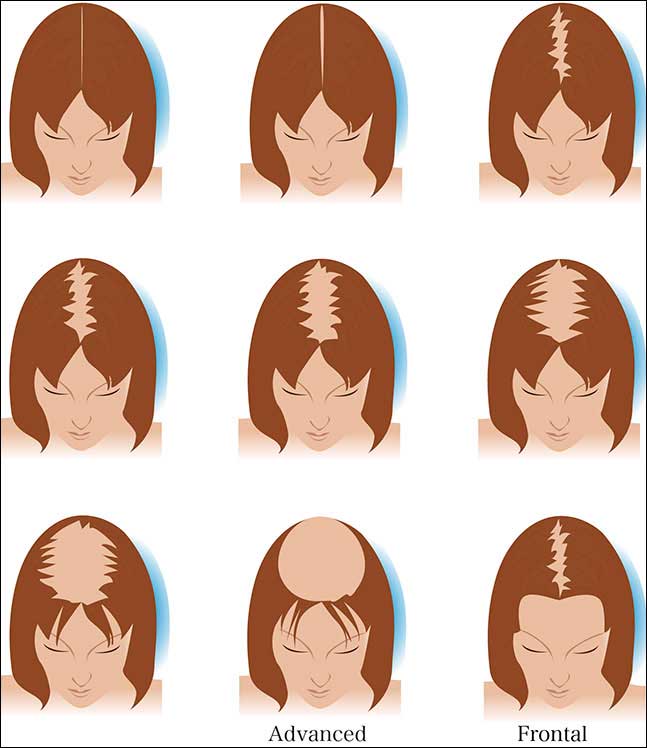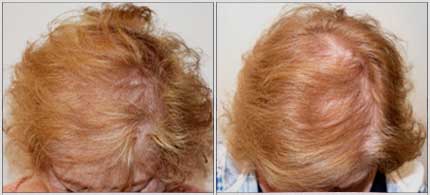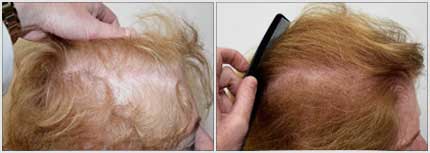Female Hair Transplant
Written by Dr. Griffin
Encourage the Growth of New Hair Using Your Own Existing Hair in Philadelphia
Thinning hair can often lead to feelings of self-consciousness and distress. What is the best way to regrow hair for women? Despite the common misconception, hair transplants aren’t only for men. An increasing number of women are choosing to have a female hair transplant in Philadelphia at Griffin Hair Restoration to counteract hair thinning due to androgenic alopecia and other causes.
Want to learn more about a female hair transplant in Philadelphia? Contact the Griffin Hair Restoration Center of Philadelphia by calling (215) 561-9100, or submit a contact form to request a consultation if you would like to discover ways of making your hair thicker and fuller.

What Is Hair Loss and Why Does It Occur?
Hair loss—also known as alopecia—is a condition that may occur on the scalp or other areas of the body. It’s associated with a variety of causes, such as genetics, hormonal changes, stress, other medical conditions, or normal aging. Female pattern hair loss (FPHL—or androgenetic alopecia, which is the most common type of hair loss in women—occurs in about 50 percent of women and is inherited from either side of the patient’s bloodline. Hair loss may skip generations and not affect parents. However, in most cases, someone in the family can be identified with some degree of hair thinning at some point in their life. Patients who have this condition may notice hair loss from as early as their late teens, and it usually becomes worse after menopause. For women distressed by this problem, there is a solution: a female hair transplant.
Female Hair Transplant Facts: What Is Female Pattern Hair Loss?
This condition is actually a process of progressive miniaturization of follicles, driven by an abnormal response to hormones. These shrinking follicles produce smaller hair over time. In other words, the follicle is not lost, just smaller.
In women, FPHL usually begins as a noticeable widening of the part line, with some recession of the hairline, especially in the temple area. Some women first notice that they have a thinner ponytail and are not able to style their hair the way they want. As time progresses, there is variable expression of the gene, such that there is progressive thinning mainly on top of the head at different rates of speed.
There may or may not be noticeable shedding. In some cases, there is more diffuse, subtle thinning—not only on top, but also on the sides and in the back of the scalp. Unlike men, women with pattern hair loss tend to simply notice sparser hair at the crown of the head, as opposed to a classic receding hairline or a bald area. Women typically don’t lose all of their hair, but their hair can become progressively thinner, especially when the problem is left untreated. At this stage, a female hair transplant may be the best course of action.
Male vs. Female Hair Transplant: How Do They Compare?
Pattern hair loss (androgenetic alopecia) is a common form of hormonally induced genetic hair loss that affects both men and women. However, this condition affects men and women differently in terms of factors such as the age hair thinning starts, the parts of the scalp where it occurs, and other health conditions linked to the problem. Most women with hair loss have a diffuse hair loss that causes thinning in all areas of the head. Women may also tend to have more thinning on the top of the scalp. For men, thinning may occur on the crown and front of the head, leading to a receding hairline or bald spot.
As the hair loss patterns for men and women differ, you may also be wondering, “How does a male hair transplant differ from a female hair transplant?” Since hair loss patterns differ, each case may require a different approach. A female hair transplant will usually be focused more on restoring the overall volume of the hair, as opposed to targeting specific areas to improve coverage.
What Are the Most Effective Treatment Options for Female Pattern Hair Loss in 2023?
Treatment of FPHL involves both medical and surgical approaches, including female hair transplant treatments. Unlike men, there is not a reliable oral medication for women to treat hair loss. In men, where the hormonal target is DHT (dihydrotestosterone), Finasteride is an effective oral medication for the preservation of thinning hair. No such well-defined target hormone is yet known in women, where it is thought that multiple hormones may be at play.
Aldactone is a diuretic drug with anti-androgenic effects, which is often prescribed in women and which may help to some extent in combination with topical medications like Rogaine®. Vitamin supplements like Biotin are also helpful, as are iron supplements in women who are iron deficient. A low dose of oral minoxidil is also very effective. Ruling out and treating underlying medical problems such as thyroid disease is also important. If these haven’t worked, you may wish to try a female hair transplant.
Real Female Hair Transplant Before & After Photos
Real Patient Before & After Photos
While medical treatments are important in maintaining and stabilizing hair loss, and in many cases markedly improving it, ultimately the most effective way to thicken the hair in women is with a female hair transplant.
Learn more about a female hair transplant from Philadelphia’s Griffin Hair Restoration Center of Philadelphia by calling (215) 561-9100, or submit a contact form to request a consultation and discuss restoring a thicker, fuller head of hair.
Who is the Ideal Candidate for a Female Hair Transplant?
Considering a female hair transplant? You may be asking, “How do I know if I am a candidate for a female hair transplant?” Most women are good candidates for the procedure because they generally have mild to moderate thinning in a distinct pattern, an intact hairline, and adequate, stable donor hair in the back of the head. Specifically, ideal patients have thinning at the hairline or top of the scalp.
Beyond those suffering from androgenic alopecia, female hair transplants also work well for women who have lost hair because of traction alopecia, trauma, or accidents, as well as plastic surgery patients who want to restore hair growth on their incision site areas.
How Do You Prepare for a Female Hair Transplant?
If you have determined that this is the right option for you, the next thing you may be thinking about is, “How do I prepare for a female hair transplant?” You will need to avoid washing your hair on the day of the female hair transplant procedure. You may need to dye gray hair several days before female hair transplant surgery to help Dr. Griffin see the hairs.
What Is the Procedure for a Female Hair Transplant?
As in men, female hair transplant surgery involves removing hair follicles from the donor area in the back of the head and transplanting or grafting them to the recipient area in the hairline and top of the head.
Harvesting from the donor area can be done using one of two female hair transplant techniques: 1) Strip harvesting, where a strip of hair-bearing scalp is removed from the back of the head and then sutured closed, or 2) follicular unit extraction (FUE), where individual follicular units are extracted using a handheld device in Dr. Griffin’s practice. Both techniques yield follicular units for transplantation. In each case, tiny incisions are made in the recipient area. Grafts containing new hair follicles are placed into these incisions.
Female Hair Transplant Results and Recovery
Women may prefer the FUE technique for a female hair transplant because, unlike the strip procedure, there is minimal pain and discomfort after the procedure. An area of the patient’s scalp is cut short, then covered with long hair after the female hair transplant procedure.
With the FUE female hair transplant procedure, there is no linear scar, as in the strip procedure. This approach allows for a shorter hairstyle.
Post-operatively, after either a strip procedure or an FUE, instructions are given to help in the recovery and healing of the new follicles from the female hair transplant. Scabs or crusts will form on the new grafts. These are best soaked off. Swelling, aching, and tightness may occur on the forehead and around the eyes, but this is temporary.
What Is Aftercare Like Following a Female Hair Transplant?
After a strip procedure for a female hair transplant, there are sutures to be removed, which is not the case with FUE. Avoid engaging in any vigorous exercise for several days after a female hair transplant. A week is usually required for healing, after which rubbing your head and resumption of normal shampooing is allowed, as is normal activity. The female hair transplant procedure is very well tolerated. You will need to avoid dyeing your hair for two weeks and avoid taking blood thinning medications or supplements directly after. Sleeping in an elevated position for the first 72 hours will help you to keep the swelling down.
How Many Female Hair Transplant Procedures Should You Have?
It’s best for you to talk to us about your long-term plan for success after your initial female hair transplant treatment. Patients sometimes ask, “Do most people need a second hair transplant?” Usually at least two sessions will be needed to maximize results, although women have the option to wait and see how the new hair looks after it is grown in. At this point, they can decide on whether they want a second transplant procedure. It’s preferable to wait at least 12 months between procedures to let the previous follicles grow in before doing the next. Although patients may never be able to restore the same amount of fullness they previously had, nor meet their exact ideal density, a female hair transplant will help to disguise any thin areas and may help them to feel more confident about their appearance.
How Long Do Female Hair Transplant Results Last?
Can a hair transplant last a lifetime? How long does a female hair transplant last? When you have hair transplanted to thinning areas, the hair will generally continue to grow for the rest of your life. The transplanted hairs will start to take on a natural appearance within about six months after you have had a female hair transplant.
Both female hair transplant techniques result in a natural appearance of the transplanted follicles. In both cases, the new follicles produce a new hair three to six months post-op. The hairs from the female hair transplant “settle in” and will continue to grow for the patient’s lifetime. More than one procedure may be necessary to completely correct the area of thinning.
Real Female Hair Transplant Before & After Photos
Real Patient Before & After Photos


10 months post 1000 graft traditional strip HT to add density to the midvertex of the scalp
What Is Available Aside from a Female Hair Transplant?
Beyond a female hair transplant, the Griffin Hair Restoration Center of Philadelphia also offers many other hair restoration options, including a male hair transplant, eyebrow transplant, beard transplant, and non-surgical options for improving hair restoration, such as platelet-rich plasma (PRP).
It is better to begin treatment earlier rather than later, though it’s never too late to do something about your hair loss. Find out more about how a female hair transplant in Philadelphia can add more volume to a thinning scalp. Get in touch with The Griffin Hair Restoration Center of Philadelphia by calling (215) 561-9100, or submit a contact form to request a consultation.


